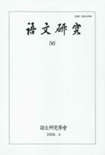- 영문명
- Study on Spatial Metaphor of imprisonment in the Early Poems of Jung-Joo Seo
- 발행기관
- 어문연구학회
- 저자명
- 박선영(Sun-Young Park)
- 간행물 정보
- 『어문연구』語文硏究 第56輯, 417~440쪽, 전체 24쪽
- 주제분류
- 어문학 > 한국어와문학
- 파일형태
- 발행일자
- 2008.04.30

국문 초록
영문 초록
This study is for recognizing through Hrushovski"s the frame of reference the extension and renewal of poet. Midang Seo jung Joo"s view with the newly created meaning by considering the spatial metaphor of imprisonment appeared at his earlier time. At that time, the imprisonment space was constructed the metaphor on the level of parallel and horizontal.
In the chapter 2, it becomes a horizontal metaphor of imprisonment. It give the shape the horizontal block by constructing of metaphor which variously changed into heterogeneous level as shown in his works such as the firmly crystallized Byuck(wall) and Moondungi(Leper). This process in which reveals clearly both the extension and renewal of Poet"s view appreciates to the interaction between uneven frames of reference.
In the chapter 3, it goes to a parallel of the sinking in water. The actual levels of position in his works such as Bada(Sea) and Muse(Untitled) put side by side with the idealized position(Reing), and through the interacting each other these frames of reference do not make a rise up to the direction towards parallel rather unite the meanings for sinking. Thus the position of imprisonment showing at the his earlier time is blending the horizontal block with the parallel sinking, and constructs a secret room fully covered with darkness. These space changes into idealized position in the real world as well.
As you see, the position-metaphor of imprisonment appeared at his earlier time characterizes the extention and renewal of his complicated view by creating new poetic meanings several times.
In the chapter 2, it becomes a horizontal metaphor of imprisonment. It give the shape the horizontal block by constructing of metaphor which variously changed into heterogeneous level as shown in his works such as the firmly crystallized Byuck(wall) and Moondungi(Leper). This process in which reveals clearly both the extension and renewal of Poet"s view appreciates to the interaction between uneven frames of reference.
In the chapter 3, it goes to a parallel of the sinking in water. The actual levels of position in his works such as Bada(Sea) and Muse(Untitled) put side by side with the idealized position(Reing), and through the interacting each other these frames of reference do not make a rise up to the direction towards parallel rather unite the meanings for sinking. Thus the position of imprisonment showing at the his earlier time is blending the horizontal block with the parallel sinking, and constructs a secret room fully covered with darkness. These space changes into idealized position in the real world as well.
As you see, the position-metaphor of imprisonment appeared at his earlier time characterizes the extention and renewal of his complicated view by creating new poetic meanings several times.
목차
1. 문제제기
2. 수평적인 폐쇄 은유- ‘벽’, ‘보리밭’
3. 수직적인 침몰 은유- ‘바다’, ‘하눌나라’
4. 결론
참고문헌
Abstract
2. 수평적인 폐쇄 은유- ‘벽’, ‘보리밭’
3. 수직적인 침몰 은유- ‘바다’, ‘하눌나라’
4. 결론
참고문헌
Abstract
키워드
해당간행물 수록 논문
참고문헌
최근 이용한 논문
교보eBook 첫 방문을 환영 합니다!

신규가입 혜택 지급이 완료 되었습니다.
바로 사용 가능한 교보e캐시 1,000원 (유효기간 7일)
지금 바로 교보eBook의 다양한 콘텐츠를 이용해 보세요!


